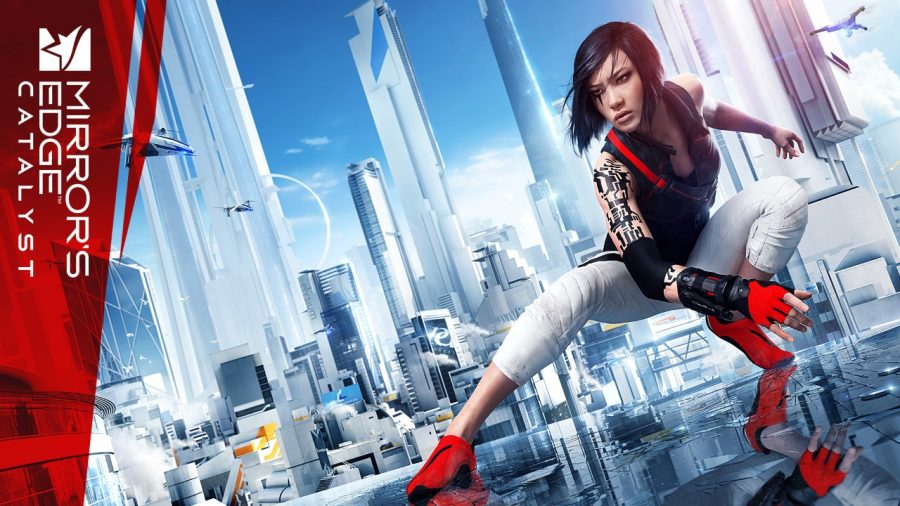Nothing is more immersive in a game than a vast world to explore except for maybe tight controls and mechanics that sync you perfectly with the character. Mirror’s Edge is a game with some of the best controls in gaming right now. The game trains you to think with their creative controls so by early mid-game, you’re running through the city of glass, jumping and climbing by instinct and forgetting completely about the controller in your hand. When they announced the sequel to Mirror’s Edge with an open world city of glass, needless to say, I was excited.
Mirror’s Edge Catalyst, the second installation in the Mirror’s Edge series, is a strong game, but not as strong as it tries to be. The controls and mechanics from the first game are all there, including some significant improvements, especially in the combat. The fast paced parkour, unsettling heights, tense hand to hand combat, all the things that made up the first game are the best things in this one. The vast improvements only make it better. The new elements are where the game falls short.
In most games with open world exploration, after the first few missions, the story takes a backseat to the world itself and all the things to discover and do. This game’s only exception is that there’s no one in the front seat. For most of the game, the characters are just there to give you missions and make the city seem less dead. The occasional cutscene break will show us a vague flashback or another chapter of the dull main character, Faith, talking to the dull side characters about the dull narrative. Occasionally we’ll get a cutscene with some real world building and plot progression, but not nearly enough for the character driven story the game is trying to tell.
This game tries to be more dramatic and grounded with it’s photorealistic style cutscenes instead of the comic book esque ones from the first game. This helps the tone and flow of the game, no longer suffering from the disconnect caused by the first game’s cutscenes. Though it helps the tone, it can’t help the writing. The story ultimately ends up feeling melodramatic. This is because the story itself is too focused on characters and emotion. Its story might work in a more linear game, where they have time to develop the characters and plot, but not with an open world game like this. In open world games, the world and gameplay take center stage, helping to create a feeling of being your own character and choosing your own adventure. Implementing a linear, character driven narrative does not work. There’s not enough time devoted to the story for it to work. Because of this, Faith’s character arc is rushed in at the end and none of the emotional payoffs have any impact. This creates a disconnect on it’s own. The story doesn’t pull you in but instead leaves you behind. Characters you barely know go through seemingly emotional trials while you wait to get back to the parkour.
The open world itself of Mirror’s Edge Catalyst isn’t the best either. It’s fun parkouring around the city of glass but it doesn’t feel much different from the first game at all. You’re still following a red path around a mostly white city. The only difference is you choose where you want to go on a map and the path is a waypoint. It’s still this way because the open world is just not compelling enough.
An example of how to do open world right is from the Farcry games. Farcry 3 and 4 have rich open worlds, diverse in scenery and things to do. Everything in the games, especially the story, is designed around the world, and pushes you to explore it. you start out being able to see only a small part of the map. By finding and climbing towers scattered throughout the map, you unlock new areas to explore and things to do. The areas and activities are diverse and fun. Each one helps to put together a convincing, living world piece by piece. Along with that, after discovering an area, you have to fight for outposts to push out the enemies occupying it. This only adds to the feeling of accomplishment. All of this makes the exploration and discovery of the open world immensely rewarding. That is what Mirror’s Edge Catalyst is missing.
Mirror’s Edge has it’s own system of unlocking special features of the map one piece at a time. The parkour towers you have to go through are some of the most fun things in the game but what they unlock is underwhelming. The only new things that are shown on the map are races and side missions, all of which are virtually the same and get old after about two of them. In the City of Glass, there’s nothing to explore. Only white building after white building. Unlike Farcry’s detailed maps and recognizable landmarks, everything in the City of Glass blends together. This is largely because of the game’s aesthetic, a dead, sterile, white city. It’s done well and gives the game a certain feel I’m sure they were going for. This aesthetic thrived in the linear first game but can’t support an open world. The dead city can be unsettling but offers no incentive to explore it and little to do outside of the story.
Overall, the game tried to do too much. It perfected its strengths but added more than it could handle. It veered from the simplicity that made the first game good, resulting in gameplay that wasn’t strong enough to support a poorly written story, and a story that wasn’t written well enough to support a dull open world.
